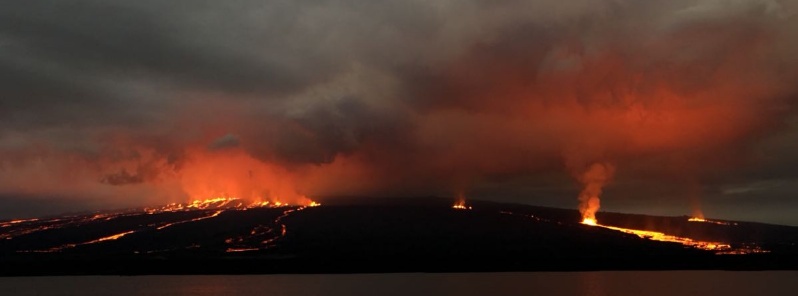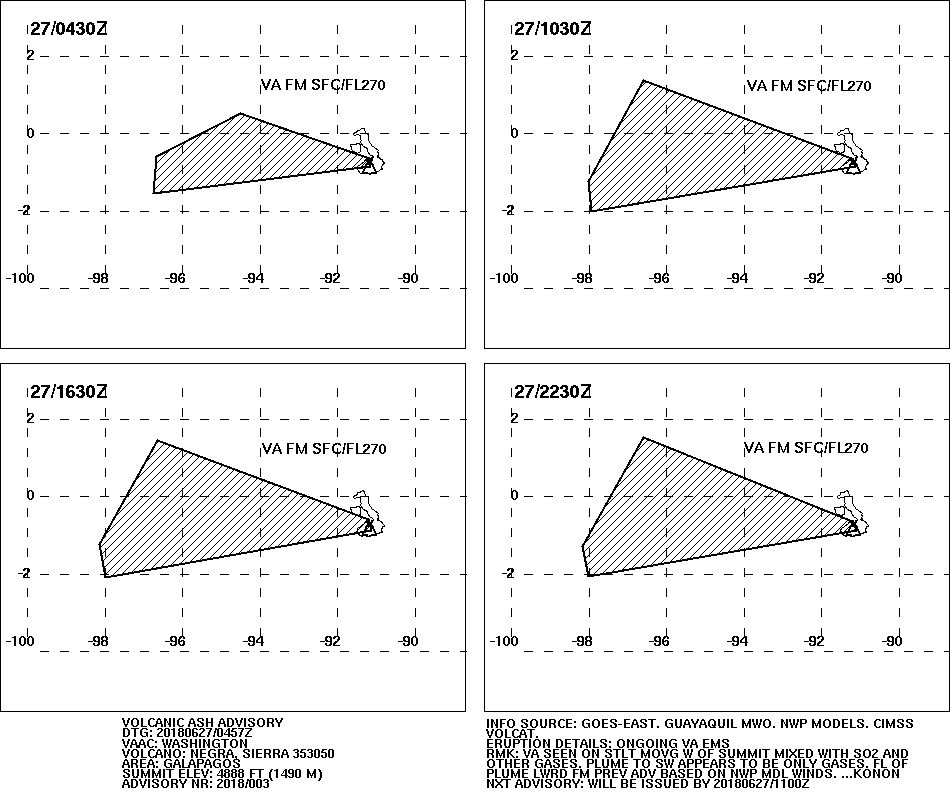Intense eruption starts at Sierra Negra volcano, evacuations ordered, Galapagos, Ecuador

A new eruption started at Sierra Negra volcano, Galapagos, Ecuador around 21:40 UTC (13:40 local time) on June 26, 2018, following intense seismicity in recent weeks. The eruption produced a plume of volcanic ash mixed with SO2 and other gases which is rising up to 8 km (27 000 feet) above sea level. Experts describe the eruption as the worst since 1979. Some say the worst in 200 years. The last eruptive phase of this volcano started on October 22, 2005, and ended on October 30 of the same year. It had Volcanic Explosivity Index of 3.
At least 50 people living close to Sierra Negra volcano on Isabela Island have been evacuated after a series of earthquakes on June 26 resulted in one of the worst eruptions of this volcano in known history.

Lava flows are being observed on the northern flanks of the volcano, directed toward the interior of the caldera and another part toward its northern flank, in the direction of Bahía Elízabeth, IGEPN reported 22:36 UTC, June 26. The eruption is producing a cloud of gas and ash which is moving to the west of the volcano.
"At the moment, there is no ashfall in Puerto Villamil," IGEPN volcanologist Dr. Benjamin Bernard said, urging residents and tourists not to approach the volcano. Puerto Villamil is a small port village located on the southeastern edge of Isla Isabela, 24 km (15 miles) SE of Sierra Negra. Of the 2 200 people who live on Isabela, the majority live in Puerto Villamil.


The alert level of the volcano is now at Orange.
While still not officially confirmed, local media say this latest eruption of Sierra Negra is the strongest in the past 200 years.
Eruption has started in #SierraNegra/#Chico Volcano. Personnel of the National Park indicate that a part of the lava flows to the interior of the caldera and another part towards the north flank, toward Bahía Elízabeth. IGEPN Rep. 9: https://t.co/jmCMyVe8GR (© Xavier Garcia) pic.twitter.com/nIJZS49M6e
— VolcanoHotspot (@volcanohotspot) June 26, 2018
Onset of the #SierraNegra #eruption (#Galapagos) in the afternoon of June 26 captured by GOES & other satellites. The previous two Sierra Negra eruptions (1979 & 2005) both emitted a lot of SO2.
Source: @NOAA/@UWCIMSS volcanic cloud monitoring system; https://t.co/OZWmWBOVs9 pic.twitter.com/Gg3Yqw6pp3
— Simon Carn (@simoncarn) June 27, 2018
#volcan #volcano #SierraNegra #Galapagos Une éruption a débuté sur le flanc nord/An eruption began on the north flank pic.twitter.com/VElJ0nOUBR
— CultureVolcan (@CultureVolcan) June 27, 2018
GALÁPAGOS: Volcán Sierra Negra en proceso eruptivo. COE activado, suspensión de visitas a zona de influencia, suspensión de clases en zona de influencia, @PoliticaEc y equipo CGREG en operativo de evacuación zonas de influencia @el_telegrafo @ElUniversal @elcomerciocom pic.twitter.com/OOOuEkgnHo
— Lorena Tapia Núñez (@LorenaTapiaN) June 26, 2018
#volcan #volcano #SierraNegra #Galapagos L'éruption est impressionnante, fissurale/This fissural eruption is really impressive; image/picture via @EndemicaTours pic.twitter.com/4z6ejdim0O
— CultureVolcan (@CultureVolcan) June 27, 2018
ISABELA: Felicitaciones al equipo interinstitucional al momento evacuadas todas las personas de la parte alta (zona de influencia) del Volcán Sierra Negra. Su erupción es un espectáculo natural que está siendo monitoreado de manera técnica y permanente @IGecuador pic.twitter.com/hIapuo26O7
— Lorena Tapia Núñez (@LorenaTapiaN) June 26, 2018
#VolcanSierraNegra entra en erupción en #Galapagos, aún no se reportan daños materiales o víctimas pic.twitter.com/3HVV2sLPdY
— Confirmado.net (@confirmadonet) June 26, 2018
¡MAGIC GALAPAGOS!
On board of the National Geographic Endeavour.#SierraNegraEruption#Galápagos @LindbladExp @NatGeo @SvenLEX @ralphleehopkins @nytimes @CNNEE @bbcmundo pic.twitter.com/A6vHE4J6IM— Christian Saá (@ChristianSaa5) June 27, 2018
Les comparto algunas fotos de la erupción Sierra negra pic.twitter.com/976uFEVZRS
— Jonathan Vega #CSE (@jona57_vega) June 27, 2018
Hoy aproximadamente entre las 13 y 14 horas aproximadamente comenzó la #erupción del #VolcanSierraNegra #IslaIsabela #Galápagos este evento lo vinimos advirtiendo desde hace 2 semanas y se dio el más maravilloso espectáculo de la naturaleza. pic.twitter.com/zW56DnSgz0
— EQEC (@EQEC1) June 27, 2018
#VolcánSierraNegra Mega erupción volcánica del volcán Sierra Negra vista desde Bahía Elizabeth. Esta erupción es considerada la más grande en los últimos 200 años. pic.twitter.com/kvakD1sNW5
— Confirmado.net (@confirmadonet) June 27, 2018
According to the Washington VAAC, volcanic ash is seen on satellite imagery moving west of the summit, mixed with SO2 and other gases. Plume to the SW appears to be only gases.


On June 16, 2018, a new eruption started at nearby Fernandina volcano (Cerro la Cumbre). Lava flows reached the ocean in a matter of hours.
Geological summary
The broad shield volcano of Sierra Negra at the southern end of Isabela Island contains a shallow 7 x 10.5 km (4.3 x 6.5 miles) caldera that is the largest in the Galápagos Islands. Flank vents abound, including cinder cones and spatter cones concentrated along an ENE-trending rift system and tuff cones along the coast and forming offshore islands.
The 1124-m-high (3 690 feet) volcano is elongated in a NE direction. Although it is the largest of the five major Isabela volcanoes, it has the flattest slopes, averaging less than 5 degrees and diminishing to 2 degrees near the coast. A sinuous 14-km-long (8.7 miles), N-S-trending ridge occupies the west part of the caldera floor, which lies only about 100 m (328 feet) below its rim. Volcán de Azufre, the largest fumarolic area in the Galápagos Islands, lies within a graben between this ridge and the west caldera wall.
Lava flows from a major eruption in 1979 extend all the way to the north coast from circumferential fissure vents on the upper northern flank. Sierra Negra, along with Cerro Azul and Volcán Wolf, is one of the most active of Isabela Island volcanoes. (GVP)
Featured image: Sierra Negra volcano erupting on June 26, 2018. Credit: Endemica Tours

Commenting rules and guidelines
We value the thoughts and opinions of our readers and welcome healthy discussions on our website. In order to maintain a respectful and positive community, we ask that all commenters follow these rules:
We reserve the right to remove any comments that violate these rules. By commenting on our website, you agree to abide by these guidelines. Thank you for helping to create a positive and welcoming environment for all.